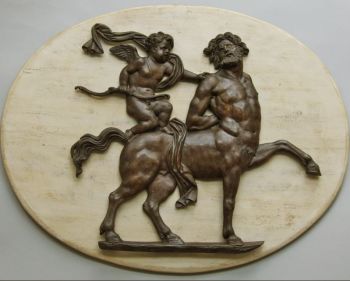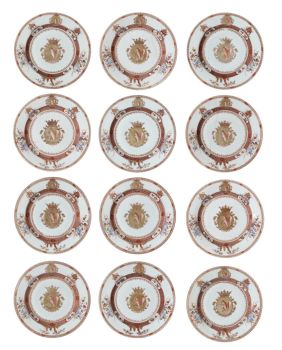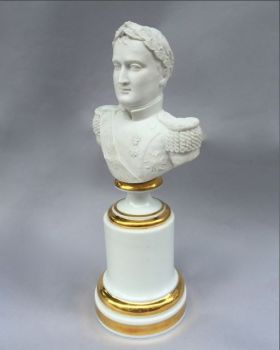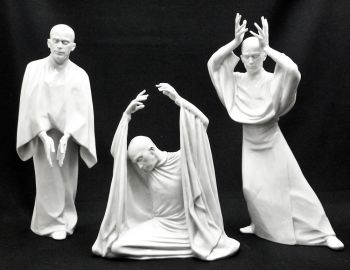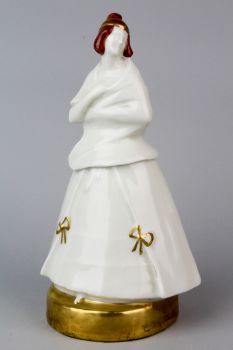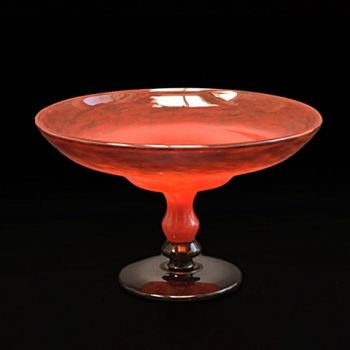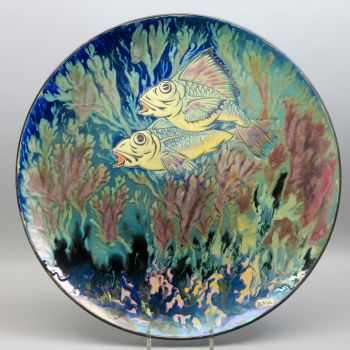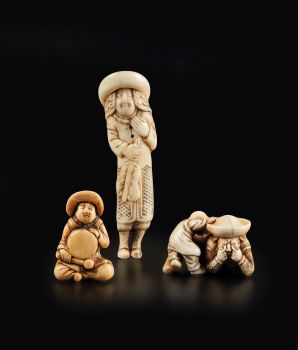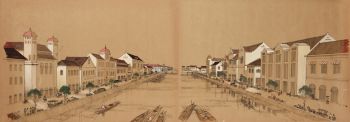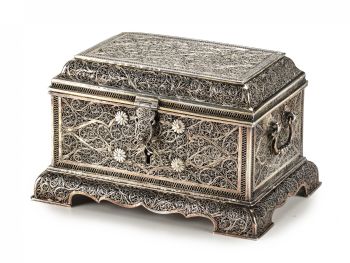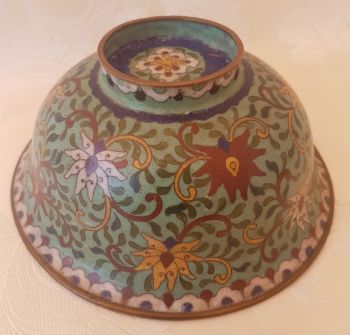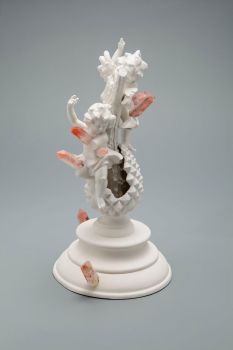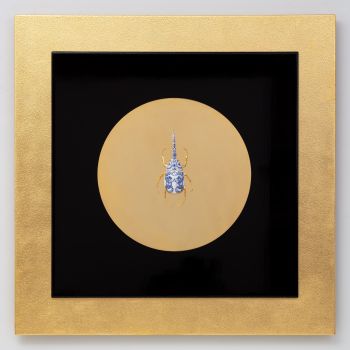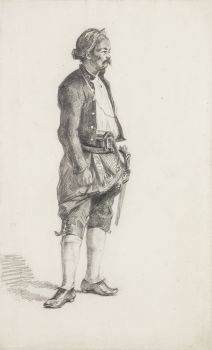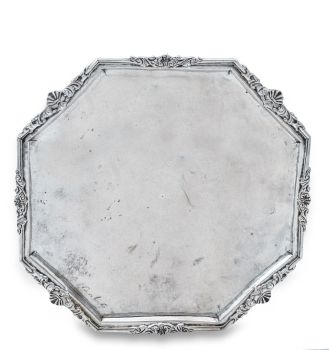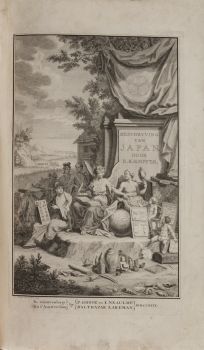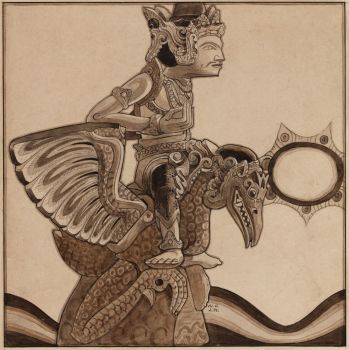UN PIATTO 'SCHREUDER' BLU E BIANCO DI ESPORTAZIONE ARMATORIALE CINESE 1735
Artista Sconosciuto
PorcellanaPorcellana cinese
ø 22 cm
Prezzo su richiesta
Zebregs & Röell - Fine Art - Antiques
- A proposito di opere d'arteQianlong period, circa 1735-1740
The rim decorated with flower sprays, centrally the coat-of-arms of the Dutch Schreuder family.
Diam. 22.5 cm
Note:
The coat of arms in the centre of the plate has been wrongly attributed to the van Heijst or van Boonen families, but in 1997 it was decided that it belonged to Clara Geertruijda de la Haye (1729-1769), the wife of Jan Schreuder (1704-1769), counsellor of the Dutch East Indies, bearing this coat of arms on her will in Batavia on 27 June 1767. However, the de la Haye family usually took another coat of arms recorded in Batavia in 1759. Therefore it seems likely that this coat of arms with the three fleurs-de-lis belonged to her husband, Jan Schreuder, who was Governor and director of Ceylon from 1756 till 1761. The same arms, though with a different crest, were borne by his three children as depicted on their tombstone in Colombo; Susanna Engelberta Schreuder (baptized Surat, 20 April 1743; died Colombo, 29 March 1760), Huijbert Joan Schreuder (born Colombo, 4 February 1759; died Colombo, 29 May 1759) and an un-baptized daughter who died soon after birth. It is interesting to note that this coat of arms is depicted in exactly the same way on a Japanese lacquered copper beaker in the Peabody Essex Museum in Salem, Massachusetts. - A proposito di opere artista
Può succedere che un artista o un creatore sia sconosciuto.
Alcune opere non sono determinate da chi sono state realizzate o sono state realizzate da (un gruppo di) artigiani. Esempi sono statue dell'antichità, mobili, specchi o firme non chiare o leggibili ma anche alcune opere non sono affatto firmate.
Inoltre puoi trovare la seguente descrizione:
•"Attribuito a …." A loro avviso probabilmente opera dell'artista, almeno in parte
•“Studio di ….” o “Officina di” A loro avviso un'opera eseguita nello studio o nella bottega dell'artista, eventualmente sotto la sua supervisione
•“Cerchio di…” A loro avviso un'opera del periodo dell'artista che mostra la sua influenza, strettamente legata all'artista ma non necessariamente al suo allievo
•"Stile di..." o "Seguace di..." A loro avviso un'opera eseguita nello stile dell'artista ma non necessariamente da un allievo; può essere contemporaneo o quasi contemporaneo
•“Modalità di…” A loro avviso un'opera nello stile dell'artista ma di epoca successiva
•"Dopo …." A loro avviso una copia (di qualsiasi data) di un'opera dell'artista
•“Firmato…”, “Datato…” o “Iscritto” A loro avviso l'opera è stata firmata/datata/inscritta dall'artista. L'aggiunta di un punto interrogativo indica un elemento di dubbio
•"Con firma....", "Con data...", "Con iscrizione..." o “Riporta firma/data/iscrizione” a loro avviso la firma/data/iscrizione è stata aggiunta da qualcuno diverso dall'artista
Sei interessato ad acquistare questa opera d'arte?
Artwork details
Related artworks
Artista Sconosciuto
Two Centaurs, France or Italylate 18th
Prezzo su richiestaRobert Schreuder Antiquair
1 - 4 / 12Artista Sconosciuto
Series of 6 Chinese cups and saucers (Yongzheng period)1722 - 1735
Prezzo su richiestaKuipers Kunst & Antiek
1 - 4 / 13Artista Sconosciuto
A Chinese porcelain blue and white 'Mantou Xin' bowl, Kangxi period (1661-1722)1700 - 1720
Prezzo su richiestaMenken Works of Art
Artista Sconosciuto
Four famille rose ‘Wu Shuang Pu’ wine cups, Guangxu mark and period (1875-1908)1875 - 1908
Prezzo su richiestaMenken Works of Art
Artista Sconosciuto
A blue and white Romance of the Three Kingdoms charger, Kangxi period (1661-1722)1661 - 1722
Prezzo su richiestaMenken Works of Art
1 - 4 / 24Artista Sconosciuto
Olandesi in miniatura (Netsuke)1700 - 1900
Prezzo su richiestaZebregs & Röell - Fine Art - Antiques
Artista Sconosciuto
UN INSOLITO PIATTO D'ARGENTO LOBBATO INDONESIlate 17th
Prezzo su richiestaZebregs & Röell - Fine Art - Antiques
Artista Sconosciuto
UN MODELLO GIAPPONESE DI UN NORIMONO, UN PALANQUIN1650 - 1700
Prezzo su richiestaZebregs & Röell - Fine Art - Antiques
Artista Sconosciuto
Olandesi in miniatura18th century
Prezzo su richiestaZebregs & Röell - Fine Art - Antiques
Artista Sconosciuto
UN NETSUKE IN AVORIO DI UN OLANDESE CHE TIENE UN GALLETTO18th century
Prezzo su richiestaZebregs & Röell - Fine Art - Antiques
Artista Sconosciuto
UN PICCOLO NETSUKE IN AVORIO DI UN OLANDESE CON UN TAMBURO1750 - 1800
Prezzo su richiestaZebregs & Röell - Fine Art - Antiques
Artista Sconosciuto
Japanese transition-style lacquer coffer 1640 - 1650
Prezzo su richiestaZebregs & Röell - Fine Art - Antiques
Artista Sconosciuto
UN NETSUKE IN AVORIO DI UN OLANDESE CHE GIOCA CON UN RAGAZZINO18th century
Prezzo su richiestaZebregs & Röell - Fine Art - Antiques
Artista Sconosciuto
COPPIA DI TORCHÈRE O PORTACANDELE IN TEAK INDONESI LACCATI E DORATI18th century
Prezzo su richiestaZebregs & Röell - Fine Art - Antiques
Artista Sconosciuto
The bell of the VOC fortress in Jaffna, Sri Lanka1747
Prezzo su richiestaZebregs & Röell - Fine Art - Antiques
 A cura di
A cura diDanny Bree
Artista Sconosciuto
A silver spoon commemorating Juff’ Margareta van Hoorn1656 - 1694
Prezzo su richiestaZebregs & Röell - Fine Art - Antiques
1 - 4 / 24Artista Sconosciuto
A blue and white Romance of the Three Kingdoms charger, Kangxi period (1661-1722)1661 - 1722
Prezzo su richiestaMenken Works of Art
Artista Sconosciuto
Four famille rose ‘Wu Shuang Pu’ wine cups, Guangxu mark and period (1875-1908)1875 - 1908
Prezzo su richiestaMenken Works of Art
Artista Sconosciuto
Series of 6 Chinese cups and saucers (Yongzheng period)1722 - 1735
Prezzo su richiestaKuipers Kunst & Antiek
Artista Sconosciuto
Four famille rose ‘Wu Shuang Pu’ wine cups, Guangxu mark and period (1875-1908)1875 - 1908
Prezzo su richiestaMenken Works of Art
Samuel Dejong
Anatomia Blue Heritage, Atlas Closed2017 - 2019
Prezzo su richiestaVilla del Arte Galleries
Artista Sconosciuto
A large Japanese Imari porcelain 'VOC Groningen' dish1800 - 1925
Prezzo su richiestaZebregs & Röell - Fine Art - Antiques
1 - 4 / 24Artista Sconosciuto
Due ritratti di studio di Mas Marco Kartodikromo1900 - 1950
Prezzo su richiestaZebregs & Röell - Fine Art - Antiques
Artista Sconosciuto
A Surinam-themed Amsterdam long-case clock1746 - 1756
Prezzo su richiestaZebregs & Röell - Fine Art - Antiques
 A cura di
A cura diGallerease Magazine
Engelbert Kaempfer
IL LIBRO DI ENGELBERT KAEMPFER1651 - 1716
Prezzo su richiestaZebregs & Röell - Fine Art - Antiques
Artista Sconosciuto
COPPIA DI TORCHÈRE O PORTACANDELE IN TEAK INDONESI LACCATI E DORATI18th century
Prezzo su richiestaZebregs & Röell - Fine Art - Antiques
Artista Sconosciuto
UN INSOLITO PIATTO D'ARGENTO LOBBATO INDONESIlate 17th
Prezzo su richiestaZebregs & Röell - Fine Art - Antiques
1 - 4 / 12



